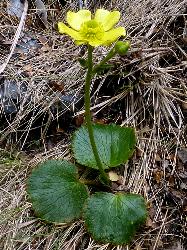- Taxon
- Gallery
- = Ranunculus monroi Hook.f., Bot. Antarct. Voy. II (Fl. Nov.-Zel.) Part II, 323 (1855)
- = Ranunculus pinguis var. α Hook.f., Handb. New Zealand Fl. 5 (1864)
- = Ranunculus ruahinicus Colenso, Trans. & Proc. New Zealand Inst. 18: 256 (1885 [1886])
- = Ranunculus muelleri Buchanan, Trans. & Proc. New Zealand Inst. 19: 215 (1886 [1887])
- = Ranunculus sychnopetala Colenso, Trans. & Proc. New Zealand Inst. 25: 324 (1892 [1893])
- = Ranunculus monroi var. dentatus Kirk, Trans. New Zealand Inst. 27: 349 (1895)
- = Ranunculus rufus Colenso, Trans. & Proc. New Zealand Inst. 28: 591 (1895 [1896])
- = Ranunculus monroi var. sericeus Kirk, Trans. New Zealand Inst. 27: 349 (1895)
- = Ranunculus insignis var. lobulatus Kirk, Stud. Fl. New Zealand 8 (1899)
- ≡ Ranunculus lobulatus (Kirk) Cockayne, Trans. & Proc. New Zealand Inst. 38: 373 (1906)
- = Ranunculus insignis var. glabratus Allan, Fl. New Zealand 1, 146 (1961)
Tufted perennial; rhizome stout. Stems erect, villous or rarely glabrous, up to 25 cm tall. Lvs simple, often coriaceous, sometimes submembranous, crenate or toothed, hairy, rarely one or both surfaces glabrous, variable in shape from oblong-cuneate to ovate to orbicular-cordate, 3–15 × 1–20 cm. Fls (1)–2–10–(20) per stem, 2–3–(5) cm diam.; pedicels hairy or glabrous. Sepals spreading, glabrous or with silky hairs. Petals 5–7–(16), yellow, narrowly to broadly cuneate-obovate; nectary single (rarely 2–3), 1–2 mm from petal base, naked. Receptacle glabrous or hairy. Achenes numerous, not flattened, hairy or glabrous; body 1–3 mm long; beak straight or curved, 1–3 mm long.
[From: Webb et al. (1988) Flora of New Zealand. Volume 4.]
Flowering: Nov.–Feb.; Fruiting: Dec.–Mar.




